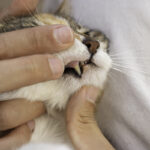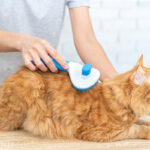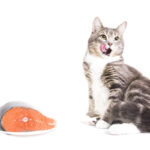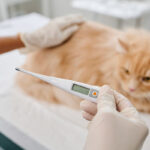Cats are highly talented at hiding their illnesses from their owners. As a pet parent, you need to look into the major changes in cats despite the kitty disguises the illness. A dental care program at home is one of the challenging parts of pet parenting, especially in the case of cats.
It could be extremely critical to examine the teeth and gums of the cat at home without the assistance of the vet. One of the major indicators of diagnosing the illness is checking the health of cat gums through their gum color. You may have wondered about your cat’s dental health when your dentist spoke about it during a recent vet visit.
Take a peek into the gum color of cats. This will help the pet owners identify potential health issues so that they can immediately consult the veterinarian and get the necessary treatment. If the cat’s gum color is dark pink and red color, it could be an indication of some underlying health condition.
The cat’s gum color indicates an emergency illness in the cat which requires immediate vet treatment. Here’s everything you need to learn about Cat Gums, healthy gum color, reasons behind unhealthy cat gums, maintenance, and treatment. Take a look!
Contents
- What Is the Normal / Healthy Gum Color Of a Cat?
- How to Monitor My Cat Gum Health?
- Various Gum Colors of Cats and Their Meaning
- Reasons for Unhealthy Gums in Cats
- Warning Signs of Gums in Cats
- When to Call a Vet for Unhealthy Gums in Cats?
- Maintaining Cats Gum Health
- Why Is Healthy Gums Important For Cats?
- Conclusion
What Is the Normal / Healthy Gum Color Of a Cat?
Wondering how does Healthy Cat Gums look like? Whenever you visit the vet for a regular checkup of your cat, the vet will take a peek into the cat’s mouth whilst performing a physical examination. The vet will thoroughly examine the cat’s gums and tell whether the cat is healthy or not.
Just by looking at the gum color, the vet will understand the dental health of the cat. If your cat is suffering from a potential health problem or even common issues like dehydration, oxygenation, and functioning of red blood cells, the cat’s gum color will reveal everything.
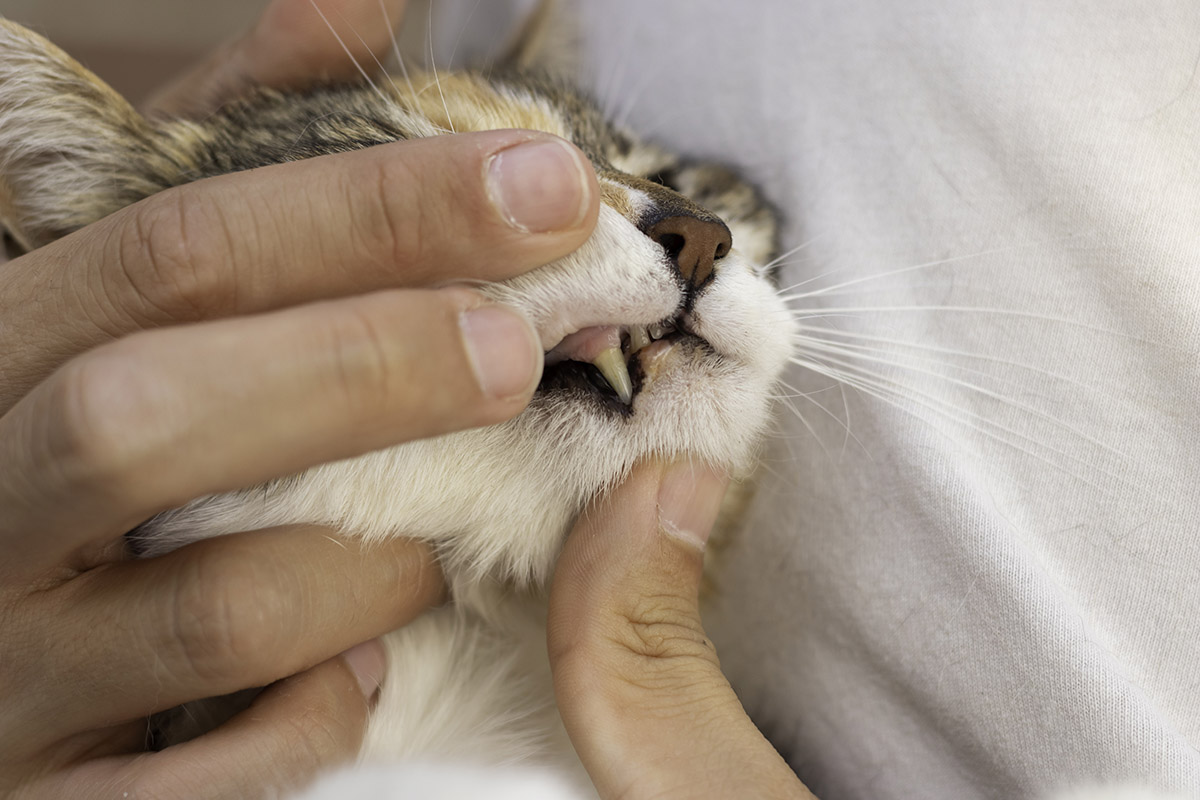
The place where your cat’s teeth and gums meet shouldn’t have redness around the gumline. No swelling, bleeding, redness, lesions, or sores should be present on the cat’s gums.
The normal gum color of cats will be either light pink or dark pink in pigmented form. The normal color of a cat’s gums will depend on the feline’s color and markings. If you don’t have an idea about how a healthy cat gum appears then, there are specific traits that indicate the kitty’s good health. Let’s look into the key characteristics that indicate healthy cat gums.
Color:
When the cat’s gums are light pink, it indicates that the cat is healthy. It’s an ideal shade that tells the health of cat gums. The shade of pink shouldn’t be too bright or too pale. However, depending on the cat’s color, the color of the gums will depend.
If the cat’s color is black or orange, we may witness spotted and black gums. It’s quite normal if this continues throughout the life of the cat. Still, it would be better if you take such a cat to the vet for a gum checkup and get assurance that the black gum color is normal.
Hydration:
To check the cat’s gum health, you can check another characteristic. Open the cat’s mouth and run a finger along the cat’s gums. When you do so, you must feel a slippery sensation on the gums coated in saliva. If you feel slippery and wet, it indicates that the cat’s gum health is good and the cat is well hydrated.
CRT:
CRT is another parameter that the veterinarians will check when taken for a routine checkup at the vet clinic. CRT is referred to as Capillary Refill Time. The vet will slightly apply pressure to the cat’s gums with a finger.
Immediately, the gums turn pale or blanch in that particular spot on the gums. After releasing the finger, that specific spot will turn a normal pink color soon. To get back to its normal appearance, if it takes more than 2 seconds then it is referred to as delayed capillary refill time.
This means that there is poor blood circulation in the cat’s body indicating dehydration. However, this may happen due to shock and some other conditions in the cat.
Texture:
Texture is another noteworthy characteristic that helps the pet parents identify the cat’s gum health. The cat’s gum texture must be smooth instead of being bumpy.
In a few older cats, we may witness brown or black spots that appear like small patches on the gum skin. It could happen due to pigmentation. It’s a quite normal process as the cat gets older. As long as the cat’s gums have a smooth texture, pigmentation will be a normal thing.
How to Monitor My Cat Gum Health?
As a pet parent, it’s your basic responsibility to monitor the cat’s health. As part of the feline’s health, dental care is one of the important things that must be taken care of by the cat owner. Monitoring your cat’s gums and teeth frequently like every week is highly important to check for any abnormalities in them.
If you find any changes in the gum color, texture, and other characteristics then, it indicates that the cat’s health is not well. If your cat is feeling sick, it’s important to monitor the cat’s gums daily.
Do you know how and when to examine a cat’s gums? Well, when you have a doubt that the cat is sick and behaving abnormally, you must consider monitoring the cat’s gums. If you are looking into the cat’s mouth for the first time to check the cat’s gum health then, just follow the simple steps furnished below.
Gather Required Supplies:
- First of all, gather all the necessary supplies before preparing to examine the cat’s gums.
- By arranging all the supplies in one place, you can completely put your focus on your cat.
- All you need before checking the cat’s gums is a small penlight and a reward for your cat.
Check the Cat’s Mood:
- Make sure your cat is calm and peaceful while examining its gums. Choose such a time and start the process.
Choose a Perfect Spot:
- Select a comfortable location with excellent lighting to get a good view of the gums and the gum color.
Get Assistance:
- If you have another family member or friend, ask them to hold the cat’s mouth wide open to thoroughly examine the oral cavity.
Check Cat’s Breath:
- If you are comfortable, smell your feline’s breath. If you get an unpleasant or foul breath from your cat’s mouth, it indicates the gums are infected.
- There’s some underlying dental problem with your cat.
- Take the cat to the vet and check for potential causes of bad breath in your cat like diabetes, kidney disease, or other critical health conditions.
Soothe your Kitty:
- Make sure you do all these whilst talking to your cat softly. This helps calm and soothe your cat.
- Throughout the process, continue to talk to the cat smoothly.
Keep the Head Back:
- Gently place your cat on the lap with its mouth facing you. Keep your cat’s head back and place your hand over the cat’s head.
Open the Cat’s Mouth:
- Pull back the cat’s mouth and upper lip using your thumb.
- Pull down the cat’s bottom lip using the other hand.
- After opening the mouth, use your thumb and index finger to open the sides of the mouth completely to get a clear view.
- Under the penlight or other flashlight, you can get a great view of the cat’s mouth, its gums, and teeth.
Examine the Cat’s Teeth & Gums:
- Thoroughly examine the cat’s back teeth. If there is any yellowish or dark material on the cat’s teeth. Also, check whether there are any broken or cracked teeth in the cat’s mouth.
- Notice the color of the cat’s gums. If the color is a healthy pink color instead of dark red or pale pink then, it’s an indication of an oral problem. In case, the gum is developing over the tooth, it is another health problem.
- Examine the gum color and tooth on the front side of the teeth and throughout the mouth. Make a note of your cat’s mouth observations.
Throat Examination:
- Last but not least, check the throat of the cat for any sort of redness or a sign of cobblestone.
- If you witness such a thing then, it’s an indication of stomatitis in cats. Stomatitis is a critical and painful health condition that is usually seen in aged cats.
Reward your Furry Friend:
- Once you are done with the cat’s mouth examination, don’t forget to reward your cat with a healthy and delicious treat.
- Giving a dental chew would be an appropriate reward for the cat.
- If you do such examinations frequently, your cat will look forward to the sweet treats you give them and support you well during the examination.
Various Gum Colors of Cats and Their Meaning
Gum color tells you everything about your kitty’s dental and overall health. Different gum colors in cats indicate various health problems in the felines. If there are any changes in the gum color of the cat, it could be a sign of underlying health issues in cats.
Some of the colors indicate a deadly health problem in the cat which requires immediate veterinary care and treatment. Although we don’t completely depend on the cat’s gum color, the color aids in diagnosing the health problem and proceeding with further treatment procedures.
If you witness a change in the gum color associated with other symptoms then, it’s a serious medical condition. To get a clear understanding of the cat’s gum colors and their meaning, just go through the Cat Gum Color Chart provided below.
| Gum Color | Meaning | Treatment Necessity |
| Pink Gums | Normal and Healthy | Doesn’t Need Treatment |
| Pale/White Gums | Experiencing shock, Anemia or low blood pressure, Poor Blood Circulation | Immediate Vet Care for proper diagnosis |
| Yellow Gums | Jaundice/Liver Damage/Hemolytic Anemia/Organ problems like Gallbladder stones | Requires Vet Appointment & Necessary Medical Tests |
| Purple or Blue Gums | Indicates Lack of Oxygen/Pneumonia/Wind Pipe Blockage | Needs Immediate medical attention |
| Dark Pink to Red Gums | Heatstroke/Toxicity/Poisoning/Critical Systemic Infection/Inflammation/Allergic Reaction or Sepsis | Requires emergency veterinary treatment |
| Black Gums | Normal in Cats with Dark Skin/Pigmentation [Lentigo] | Regular Checkup & if required, get an examination |
| Bright Red [Gumline] | Gingivitis/Periodontal Disease/Underlying Illness | Book an appointment with the vet for a dental checkup |
Reasons for Unhealthy Gums in Cats
When there’s a change in the appearance of a cat’s gums, it eventually reflects on the blood components and the blood flow mechanism in the body. Several factors contribute to oral problems in cats. We’ve compiled a list of the key reasons behind the cause of unhealthy gums in cats.
1. Dental Issues
One of the major causes of unhealthy gums in cats is dental problems. If your cat has any oral problems and poor oral hygiene then, your cat may have unhealthy gums. If you don’t maintain the cat’s teeth, gums, and mouth properly, it causes bacteria growth inside the mouth.
Improper care and no hygiene may eventually lead to dental problems in cats. If you witness any changes in the cat’s gums like the gum color and appearance then, it indicates dental disease in cats.
The attack of bacteria on the soft tissue and gums will be more visible to the eyes compared to the damage caused by hard tooth enamel and roots inside the mouth.
2. Underlying Health Problems
Different health problems in the cat may cause unhealthy gums. Some of the underlying health problems include Feline Immunodeficiency Virus [FIV], Feline Leukemia Virus [FeLV], Calicivirus, Bartonellosis, etc.
All these health issues may cause dental disease and poor gum health in the felines. Other health problems that may affect the cat’s immune system include kidney diseases, Diabetes, and other organ damage.
Kidneys play a vital role in processing and producing urine. The major duties of kidneys include regulating blood pressure and producing red blood cells. If there is a failure of a kidney in cats, it causes blood pressure abnormalities, diminished production of red blood cells, and poor blood circulation.
Even, heart problems in cats may bring changes in the blood flow, blood pressure, and blood supply to different tissues of the body. We may witness this especially due to congestive heart failure [CHF].
If the cat has oral cancer then, it is very hard to treat them. If you witness some of the signs like drooling, bad breath, unable to eat food, raised lumps in the cat’s mouth, uninteresting to eat, etc., then, it could likely be a malignant oral tumor in the cat. In that case, make an appointment with your vet as early as possible.
3. Breeds
Cat’s breed or genes could be another cause of unhealthy gums in cats. In some rare cases, genetic factors may affect the cat’s gums. In some cat breeds, there could be a risk of developing gingivitis and other oral diseases.
The cat breeds that are highly prone to oral diseases include Abyssinian, British Shorthair, Maine Coon, Siamese, and Brachycephalic breeds like Persians. If you witness such a problem in your cat, understand its breed type and inform the same of the vet. It would be helpful to give treatment to the cat accordingly.
4. Shock
Wondering how shock impacts the health of gums in cats? Well, physical or psychological shock in cats may affect the blood flow. When the cat is in shock, the body may not be able to get enough blood flow to all the vital body organs.
The cat may get shocked for various reasons and also, there are a variety of shocks. The key causes of shock in cats include physical trauma, loss of blood, dehydration, critical blood-borne infections, toxic ingestion, allergic reactions, and more. When there is decreased blood flow to the heart, it causes a decline in blood pressure and sometimes damage to the heart.
When the cat’s gums look pale or white, it indicates that the blood isn’t flowing throughout the organs as it should. It’s one of the common signs of shock in felines. Due to internal and external bleeding and an allergic reaction, the cat may get into shock.
5. Blood Loss
Blood Loss is caused due to Anemia and this happens when the count of red blood cells diminishes because of some blood loss. Red blood cells hold the responsibility to carry oxygen and other nutrients to the tissues across various body parts.
If the cat is suffering from anemia, it indicates that there are inadequate red blood cells to circulate throughout the body and provide oxygen and other nutrients to the tissues within the body. Hence, red blood cell count is highly important for the health and overall well-being of the cat.
Also, anemia could be a severe health problem if left untreated in cats. Due to anemia, we may witness cats’ gums turn white or pale. The reason is that there aren’t adequate red blood cells in the body to distribute oxygen to the body organs they require.
As there is less blood flow into the gums, the gums turn white or pale in cats with anemia. Apart from these, other causes of blood loss in felines include fleas, ticks, infestations, trauma, intestinal worms, hookworms, and more.
6. Gums Growing over Teeth
Gums growing over teeth is also referred to as Gingival Hyperplasia. It is a medical condition in which the cat’s gingival tissue becomes enlarged and inflamed.
Enlargement generally occurs in the cat due to the growth of bacteria or dental plaque along the gumline. We may witness this sort of condition rarely in cats. The pet parents can take necessary care and prevent this condition through proper hygiene and good dental habits.
Warning Signs of Gums in Cats
Have you noticed Pale Gums in Cats? If so, then it could be an indication of severe health problems in cats. Apart from pale gums, we can witness certain warning signs through which we can understand that there’s some problem with the cat’s gums. Check out the following warning indications you observe in the cat even if the cat’s gum color is normal pink.
Inflammation: If the area wherein the gumline meets the teeth becomes swollen or red, it may indicate that there is an inflammation or dental problem in the cat. When the inflammation increases the gum tissue also bleeds quickly. It’s a major warning sign that your cat’s gum health is at risk.
Change in Color: As we have mentioned in this article, a change in the color of the gums has a significant impact on dental health. Each color tells a different health problem in the cat. Pale gums indicate that the cat is suffering from poor blood circulation, anemia, low BP, etc. Yellow gums indicate that the cat is suffering from organ failure, jaundice, and others. Likewise, each color tells a different health problem in the cat.
Lesions: If you witness gum damage, injuries, or abnormal masses on the cat’s gums, raised tissue, and others, make sure you visit the veterinarian immediately. It’s another warning sign stating that the cat’s gum health is not good.
Dryness: Have you noticed your cat’s gums? If they are moist then, it indicates that the gums are good in health. It means that the cat’s body is hydrated well. If the gums are dry then, it is an indication of dehydration which is a major health concern in the cats.
Overgrowth: If the cat’s gums grow over teeth, it is a sign of gingival hyperplasia. It is otherwise referred to as proliferative gum tissue. This problem may arise in cats due to bacteria or any dental problem in the cat’s mouth.
When to Call a Vet for Unhealthy Gums in Cats?
If your cat displays any other symptoms of illness such as loss of appetite, lethargy, breathing problems, vomiting, Diarrhea, indication of pain, etc., don’t give any home-specific treatment to the cat. Instead, take the cat to the vet immediately. As mentioned already, if the gum color is very pale, bright red, blue or purple, yellow, and other colors then, seek veterinary care immediately.
Once you suspect a dental problem in your cat, the first thing you need to do is to seek medical attention as early as possible. If ignored, the gum problem may develop into a severe condition such as Stomatitis. To avoid painful sores and removal of teeth in your cat, react to your cat’s situation and provide the necessary treatment from the veterinarian.
The veterinarian will perform the necessary physical examination at the clinic for any abnormalities with the cat’s teeth, gum color, etc. The vet will ask the pet parent regarding the dental disease symptoms, and suggest essential medical examinations.
Through the medical tests, the vet will be able to assess whether the problem is a basic organ dysfunction, illness, or critical dental problem. The vet will diagnose the accurate cause of the cat’s gum problem after performing multiple medical tests.
Some of the medical examinations performed on the cat by the vet include:
- Physical Examination
- Fecal Examination
- Blood Work
- Diagnostic Imaging
- Urinalysis
Considering the cause of the issue, the vet will provide the necessary treatment. The treatment options include supportive care, medication, IV fluids, nutritional therapy, Euthanasia, surgery, blood transfusion, warming the pet, oxygen supplementation, etc.
As per the treatment plan, the vet may probably provide medication to treat the gum-specific disease in cats. For instance, felines that underwent surgery will be given pain medication to get relief from the pain and discomfort during the healing period.
In case, the cat is suffering from gum problems due to anemia or parasites, the vet will prescribe medication to completely eradicate the parasites and even its larvae.
Maintaining Cats Gum Health
As a responsible pet parent, it’s important to pay attention to the feline’s oral health. To evade gum issues in cats, the pet owner needs to maintain the cat’s mouth and teeth. Make sure you take adequate care of your cat’s dental health so that it doesn’t get any sort of diseases such as stomatitis, gingivitis, periodontitis, and more.
Prevention is vital to maintain healthy gums in cats. The maintenance requires regular dental checkups at home and professional dental care whenever recommended by the veterinarian. Here are some of the steps that you can follow to maintain the health of your cat’s gums. Go through the preventive measures furnished below:
Dental Cleanliness: The most and first important step is to brush the teeth of the cat daily using pet-safe enzymatic toothpaste. You can find the best cat-specific dental toothpaste online and at various pet-care supply outlets. You can get a wide variety of flavored toothpastes available in the market.
Dental Supplements: Another way of maintaining cat’s gums and their health is to use dental supplements. The pet parents will be able to remove tartar and plaque buildup on the cat’s gums and teeth using these dental supplements.
Dental Chews/Toys: Provide dental chews to your cats so that it helps in maintaining the cat’s gums and teeth. Even, dental toys help maintain the health and hygiene of the gums and teeth.
Dental Solutions: The Veterinary Oral Health Council [VOHC] has approved the best dental solution for pets namely Adquadent water additives dentak solution.
Nutrient-Dense Diet: Feeding a highly nutritional diet that is high in protein content and low in carbohydrates helps maintain the health of the cat’s gums. Provide the best oral diet to your cat so that you can maintain the feline’s health in the best possible way. If the cat’s body receives all the essential nutrients it requires through the diet, it helps in maintaining the cat’s gum health.
Dental Wipes: You can clean the teeth of cats using oral cleansing wipes to maintain the cat’s gum health.
Frequent Vet Check-Ups: Take your cat for regular checkups with the veterinarian to keep an eye on your cat’s overall health. This way, you can prevent the further progress of some health problems into complicated conditions in the cat.
Safe Environment: Try to place your cat in a safe and hygienic living environment so that it will remain away from harmful hazards. Some of the harmful things include sharp objects, poisonous substances, and more.
Vaccinations: Make sure you give vaccinations to your cat up to date without missing a single vaccine. It is also important to use parasite preventatives to safeguard your cat against various diseases and infections.
Access to Fresh Drinking Water: Provide fresh drinking water to the cat daily. If possible, set up a water fountain in the cat’s place so that it gets attracted to the fountain and drinks adequate water to remain hydrated.
Why Is Healthy Gums Important For Cats?
Healthy Cat Gums indicates the well-being of the cat. Healthy gums enhance the ability to chew hard things without getting loose. The health of the cat’s gums can be assessed through its color. If there is any change in the normal pink color of the cat’s gums then, it indicates that there’s some underlying medical condition with the cat.
If the cat’s gums are dark red, black, purple, blue, yellow, and pale pink then, it indicates a dental problem or some other health issue in the cat. If the cat’s gum color change is associated with a few symptoms like lethargy, vomiting, breathing issues, etc., then, immediate vet care is required.
One of the serious dental problems in cats is Gingivitis. Gingivitis is referred to as the inflammation of the gum line. When the cat is suffering from this problem, it causes pain in the cat’s gums. If left untreated, this problem leads to gum recession, tooth sensitivity, pain, etc.
Gingivitis can sometimes cause periodontal disease in cats i.e., infection, tooth decay, infection, etc. In some dental problems, bacteria enter into the bloodstream eventually showing an impact on other major organs.
The organs that are affected by dental disease in cats include the liver, heart, brain, kidneys, etc. In aged cats, dental problems lead to cognitive dysfunction. As a result, the cat may lose excess weight, have nutritional disorders, and experience pain while eating.
An underlying health issue may initially show dental problems in the cat, especially through the gum color. Hence, it is clear that the overall cat health depends on the gum health of the cat.
Conclusion
Well, this is everything you need to understand about the Cat Gums, their health, cat gum color, and more. Gum Color shows everything whether your cat has some health problem or not. If you notice anything abnormal with your cat alongside the change in gum color, just take the cat right away to the vet.
Get the right treatment for your cat to cure pale gums in cats, and other oral problems. If you have any queries regarding this topic, let us know in the comments section. Stay in touch with our website ‘TheCrazyCats.Net’ for more articles about cat health problems, food habits, behavior, types of cats, etc.


